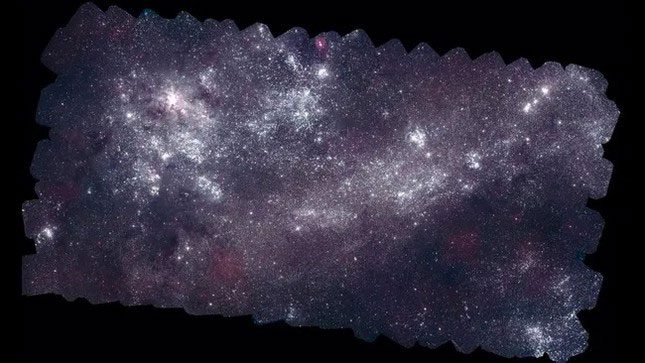The discovery of stars stripped of their outer hydrogen layer by companion stars enhances our understanding of supernovae.
Astronomers have identified 25 stars in two of the Milky Way’s satellite galaxies that have had their hydrogen-rich outer layers stripped away by a binary system, revealing them as helium stars.
These hydrogen-stripped stars represent the ancestors of a particular type of supernova – an explosion that occurs when massive stars die, giving rise to black holes or neutron stars.

The Large Magellanic Cloud, a satellite galaxy of the Milky Way where these stripped stars were found. (Photo: NASA/Swift/Immler (Goddard)/Siegel (Penn State)).
When massive stars die in a brilliant supernova explosion, they often shine brighter than the combined light of all the stars in their surrounding galaxy. Until now, evidence of these hydrogen-stripped stars has largely been overlooked by scientists. This marks the first time a population of these hydrogen-stripped stars has been discovered.
“For one or two decades, we have known that most massive stars are actually in binary systems, and one in three stars is close enough to undergo this process, where its hydrogen shell is stripped away by the gravitational influence of the other star,” said Maria Drout, an assistant professor in the Department of Astronomy and Astrophysics at the University of Toronto and a co-author of a new study on these stars. “The universe only makes sense if these stars exist and are very common. However, only a few were known until we conducted this research, so this is really a big deal.”
How do hydrogen-stripped stars remain hidden?
“Hydrogen-stripped stars are incredibly difficult to detect because the removal of their outer layers leaves them as extremely hot, exposed stellar cores,” Drout explained. This means they emit most of their light in the ultraviolet region of the electromagnetic spectrum, exceeding the range visible to the human eye.
Ground-based telescopes struggle to observe ultraviolet light as it is heavily absorbed by Earth’s atmosphere. Dust in the Milky Way absorbs even more of this light, making hydrogen-stripped stars nearly undetectable. However, our view of satellite galaxies like the Large Magellanic Cloud (LMC) and Small Magellanic Cloud (SMC) is much clearer when using telescopes outside Earth’s atmosphere.
The research team discovered the population of stripped stars using data from the Swift Ultraviolet/Optical Telescope, which has observed millions of stars from its low Earth orbit.
Just as the Sun will expand into a red giant when it runs out of hydrogen in its core in about 5 billion years, Drout noted that massive stars undergo a similar expansion into red supergiants as they deplete their hydrogen core.
Drout and the research team hypothesize that the 25 newly discovered stars will eventually explode as hydrogen-poor supernovae.
If a supernova creates a neutron star and does not eject the companion star far away, the material transfer between the stars could change. The star that previously consumed the dead star would then start losing its hydrogen-rich outer layer under the gravitational pull of the new neutron star companion.
This could lead to a second hydrogen-poor core-collapse supernova in the binary system, thereby forming a system with two neutron stars orbiting each other. As these neutron stars spiral around one another, they will lose angular momentum by emitting gravitational waves, eventually causing them to merge and emit a burst of light known as a kilonova.


















































